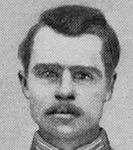 Open main menu
Open main menu
 Open main menu
Open main menu

T.M. Allen
(1839 - 1911)
Home State: North Carolina
Branch of Service: Infantry
Before Sharpsburg
Age 21, a 6 foot 2 inch tall farmer from Hyde County, he enlisted as Sergeant, Company E, 4th North Carolina Infantry on 3 June 1861 in Beaufort County. He was commissioned 2nd Lieutenant on 18 August 1862.
On the Campaign
He was wounded and captured in action at Sharpsburg on 17 September 1862.
The rest of the War
He was promoted to First Lieutenant, date not given, and was exchanged on 8 November 1862 at Aiken's Landing, VA. He was wounded at Chancellorsville, VA in May 1863, ill at Gettysburg on 1 July, and captured there on 4 July 1863. He was promoted to Captain on 28 October 1863 while a prisoner: he was held briefly at Fort Delaware, at Johnson's Island, OH, to February 1864, then at Point Lookout, MD.
In the Summer of 1864 he became one of the "Immortal 600" - captured Confederate Officers sent to Morris Island, SC as human shields. This followed an earlier Confederate action which placed about 50 high-ranking Federal officers in Charleston, SC to shield against Federal shelling of the city. Those officers were duly exchanged in August, but the Federals hoped that keeping the "Immortal 600" under fire would ensure a good trade for more Federal officers held elsewhere. After 6 weeks, with no further prospect of prisoner exchanges, Captain Allen and the rest of the surviving prisoners were sent to Fort Pulaski near Savannah, GA.
In August 1864 he was moved to Hilton Head, SC and in March 1865 returned to Fort Delaware, where he took the oath of allegiance and was released 12 June 1865.
After the War
He was a farmer in Aurora, Beaufort County. In the late 1880s he was chosen as the model for the statue atop the Washington, NC Confederate Soldiers Monument. In July 1908 he applied for a NC soldier's pension in Aurora - his doctor citing disability from 5 wounds (including Sharpsburg): "through the head, breast, thigh, and two flesh wounds". He was admitted to the Soldier's Home in Raleigh in December 1908 and lived there until shortly before his death in 1911.
References & notes
Service from Moore1 and the Roster 2 via the Historical Data Systems database. Details from Douglas J. Butler's North Carolina Civil War Monuments: An Illustrated History (2013) and his pension and Soldier's Home documents online from the NC State Library. His gravesite is on Findagrave. His picture from one in Clark.3
More on the Web
See more about the Immortal 600 in Tim Cunningham's piece, originally in the January 2003 issue of America's Civil War.
The harsh and unusual conditions of their imprisonment inspired one of the captives, John O. Murray, to record his experiences in the 1905 book The Immortal Six-Hundred. The name he gave the group stuck, and today they are still referred to as the 'Immortal 600.'
Birth
10/04/1839; Raleigh, NC
Death
09/03/1911; burial in Allen Family Cemetery, Aurora, Beaufort County, NC
1 Moore, John Wheeler (compiler), and State of North Carolina, Roster of North Carolina Troops in the War Between the States, 4 volumes, Raleigh: Ashe & Gatling, State Printers and Publishers, 1882, Vol. 1, pg. 135 [AotW citation 21453]
2 Manarin, Louis H., and Weymouth Tyree Jordan, Matthew M Brown, Michael W Coffey, North Carolina Troops, 1861-1865 : A Roster, 20 Volumes +, Raleigh: North Carolina State Department of Archives and History, 1966- [AotW citation 21454]
3 Clark, Walter, editor, Histories of the Several Regiments and Battalions from North Carolina in the Great War, 1861-1865, 5 vols., Raleigh and Goldsboro (NC): E. M. Uzzell, Nash Brothers, printers, 1901, Vol. 1, opposite pg. 256 [AotW citation 21455]